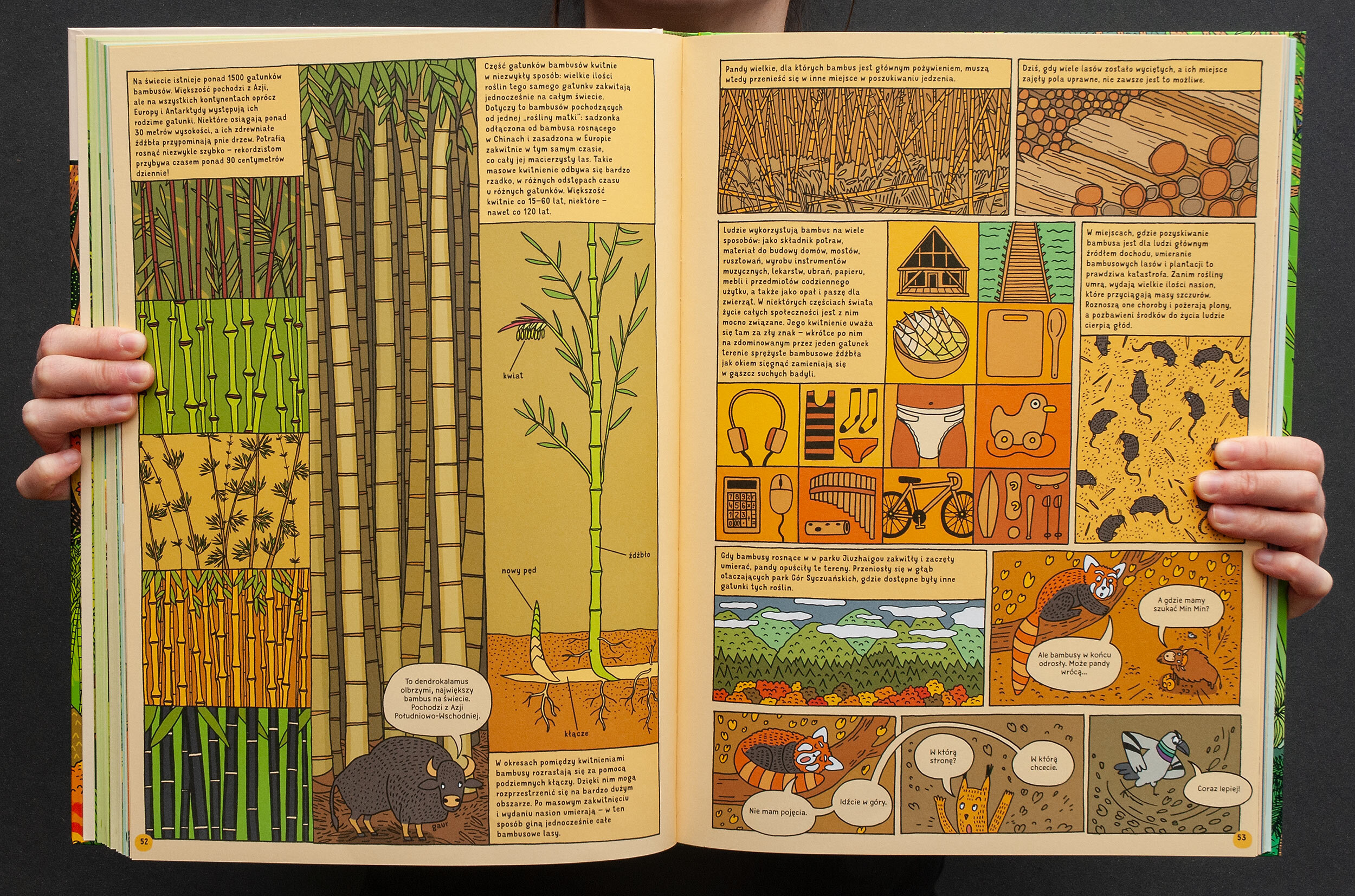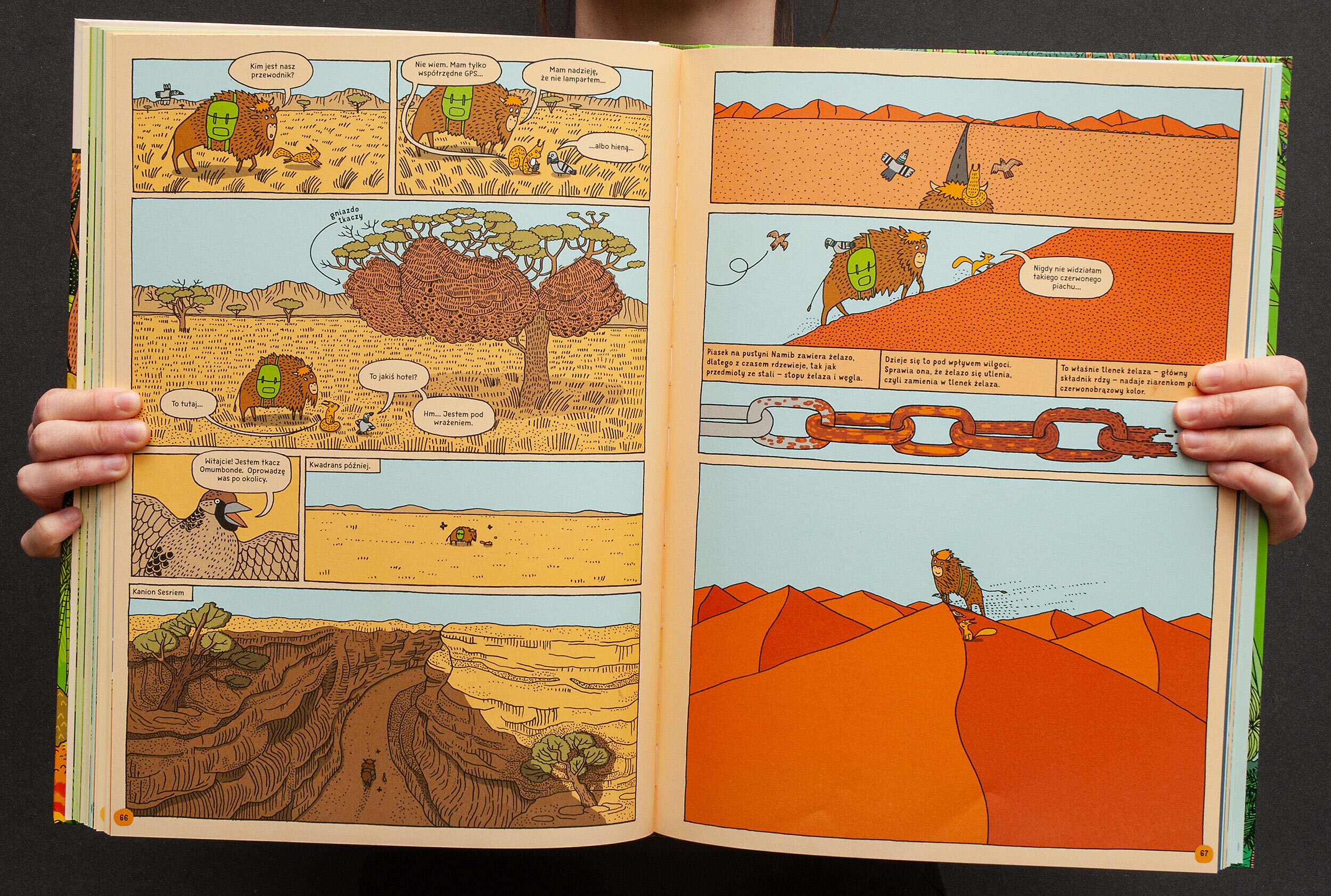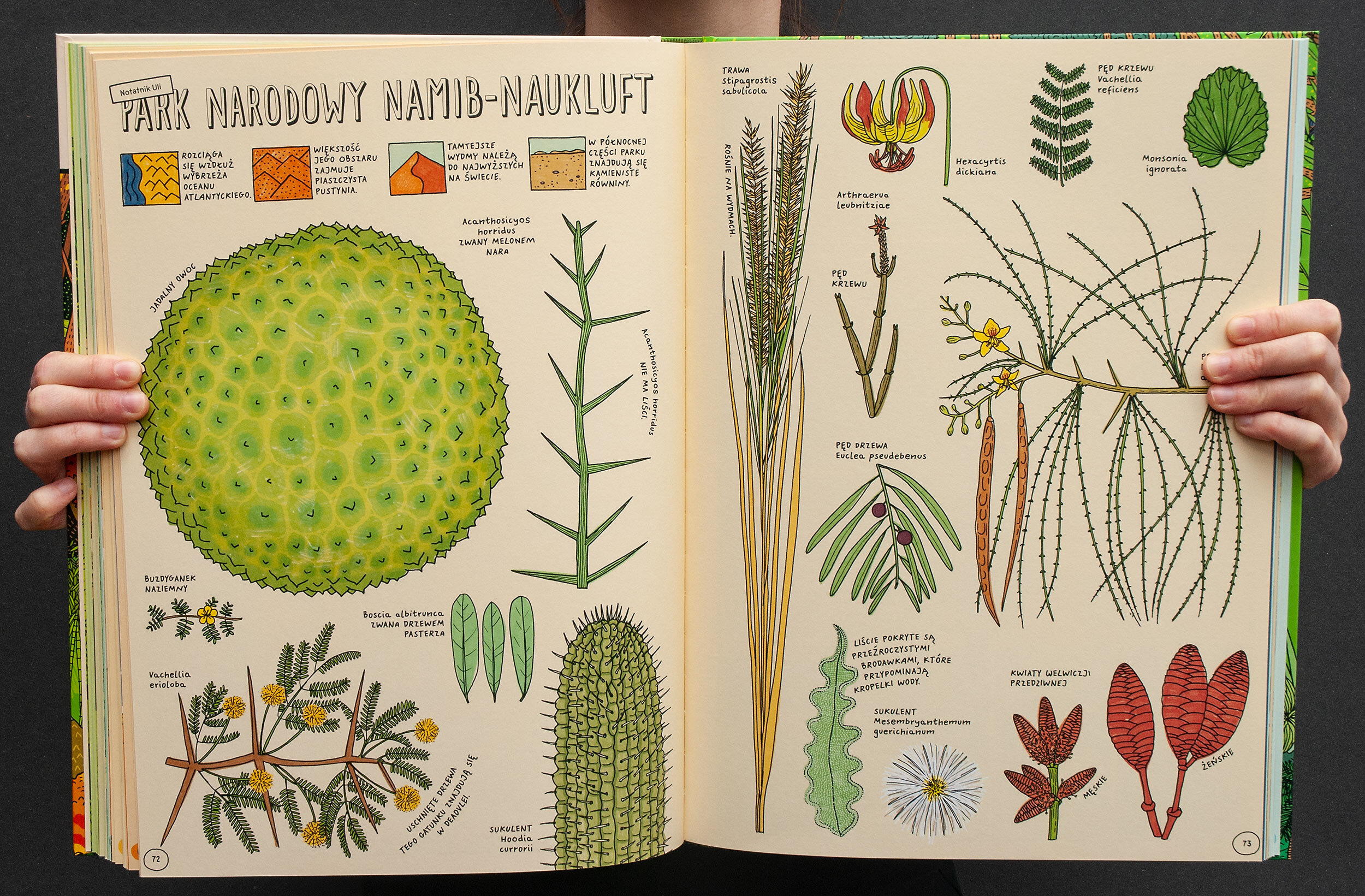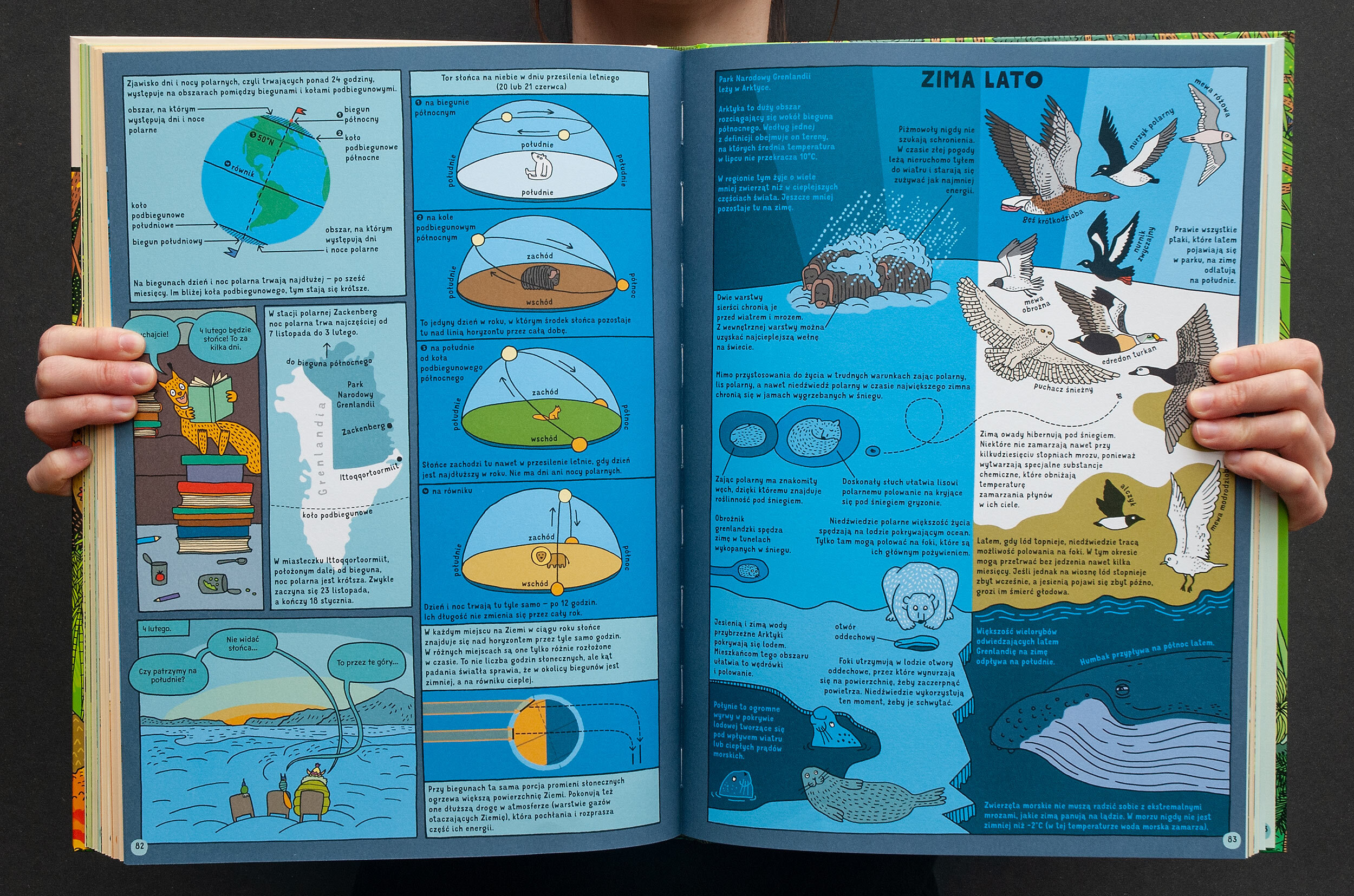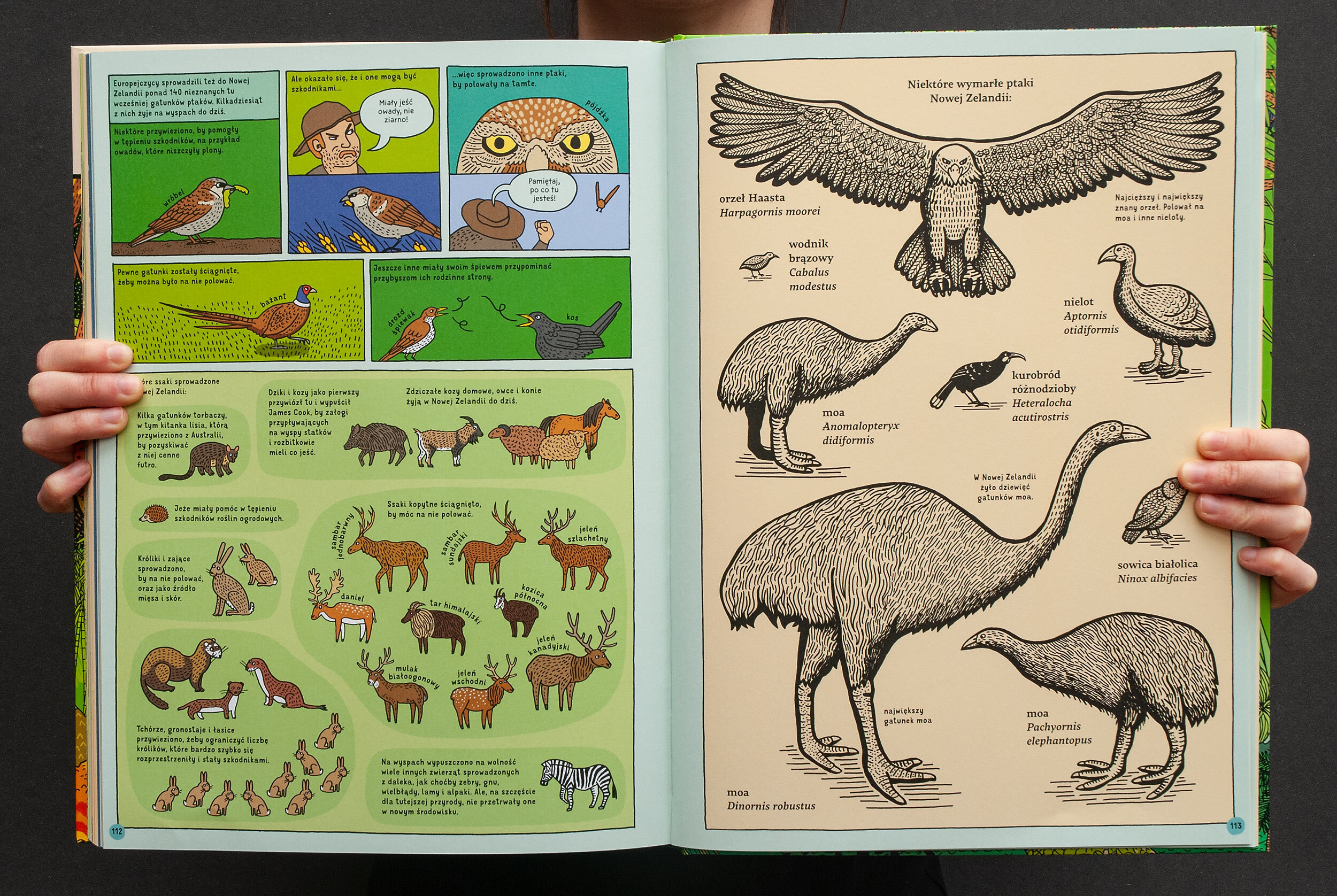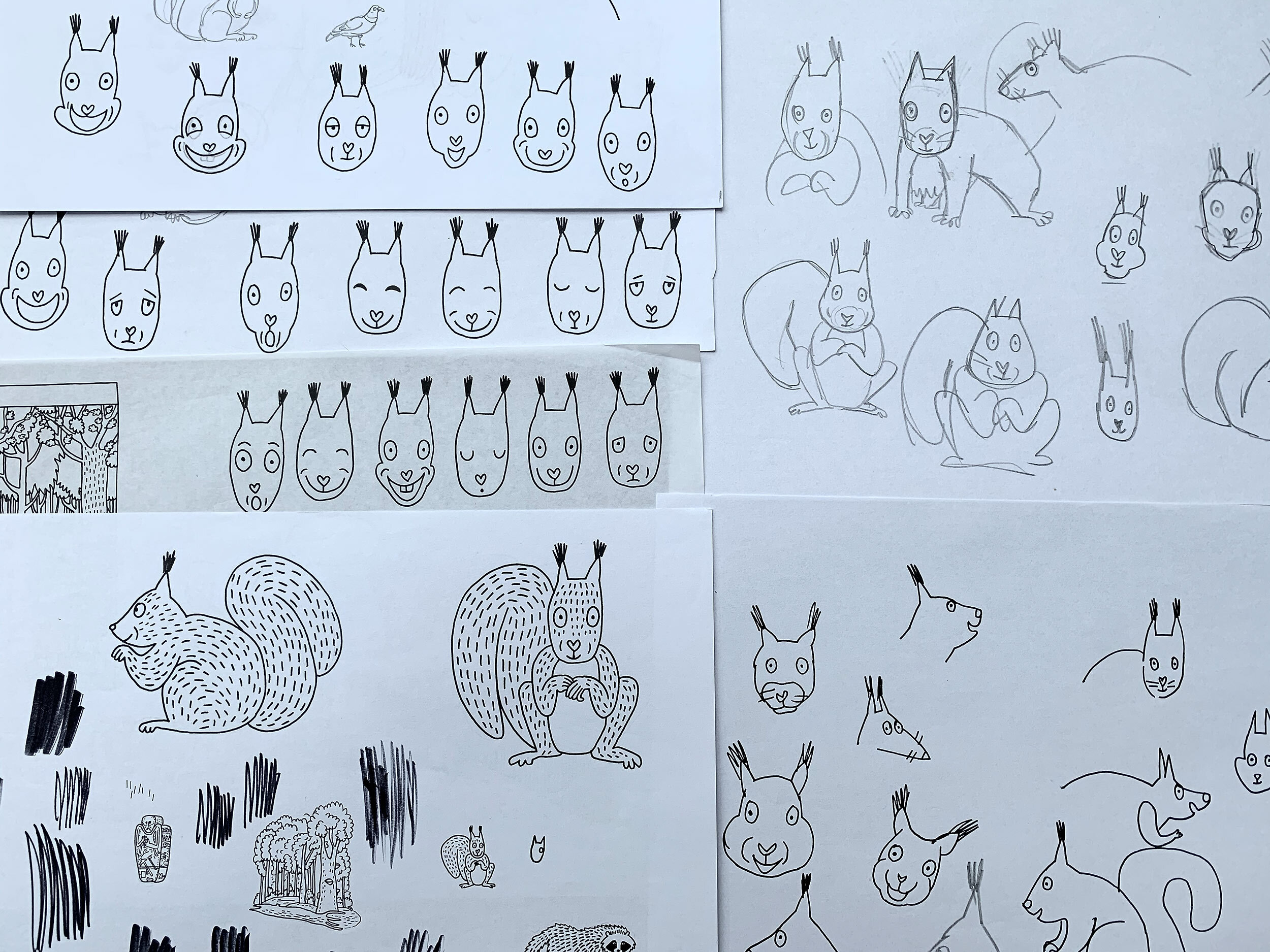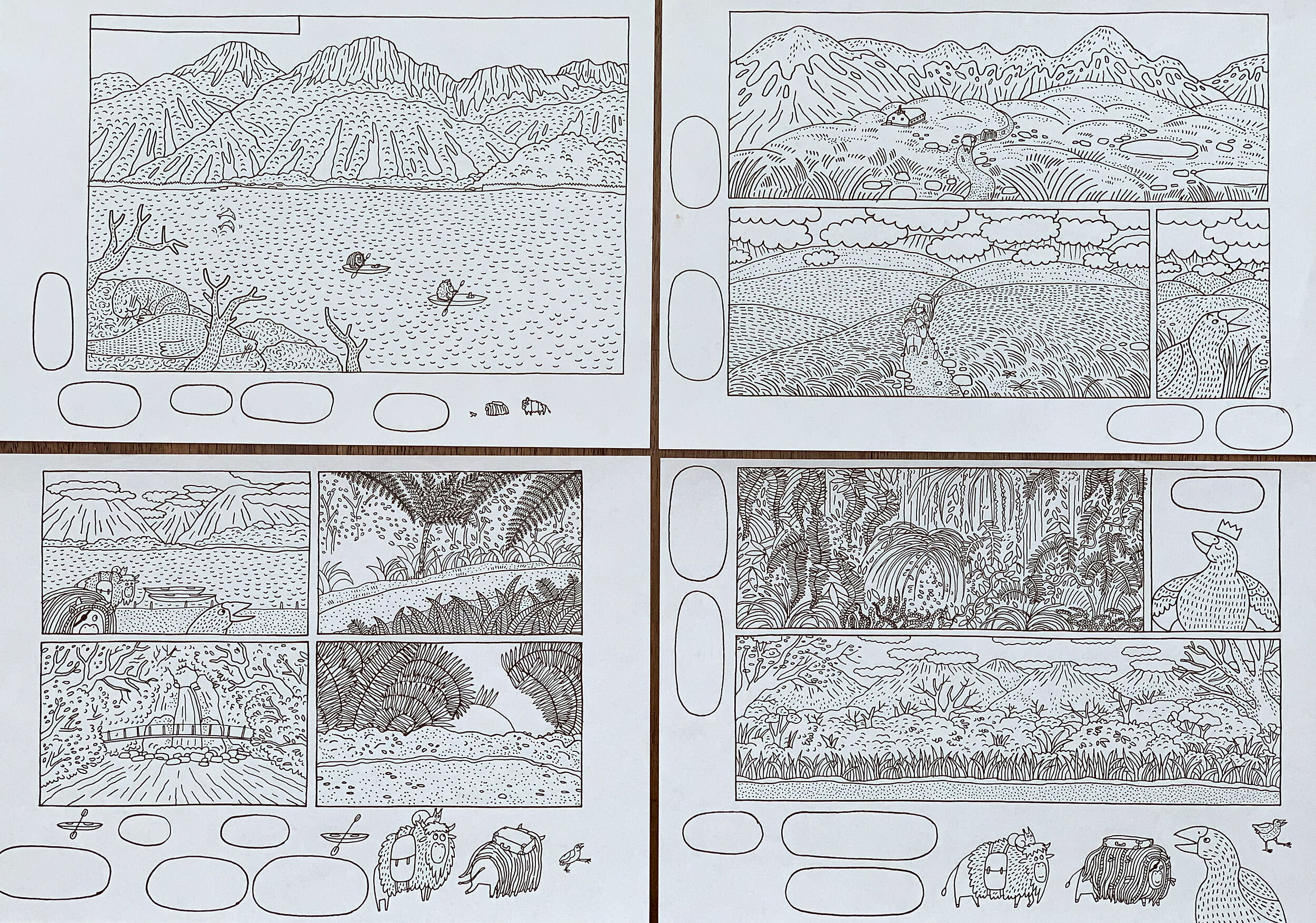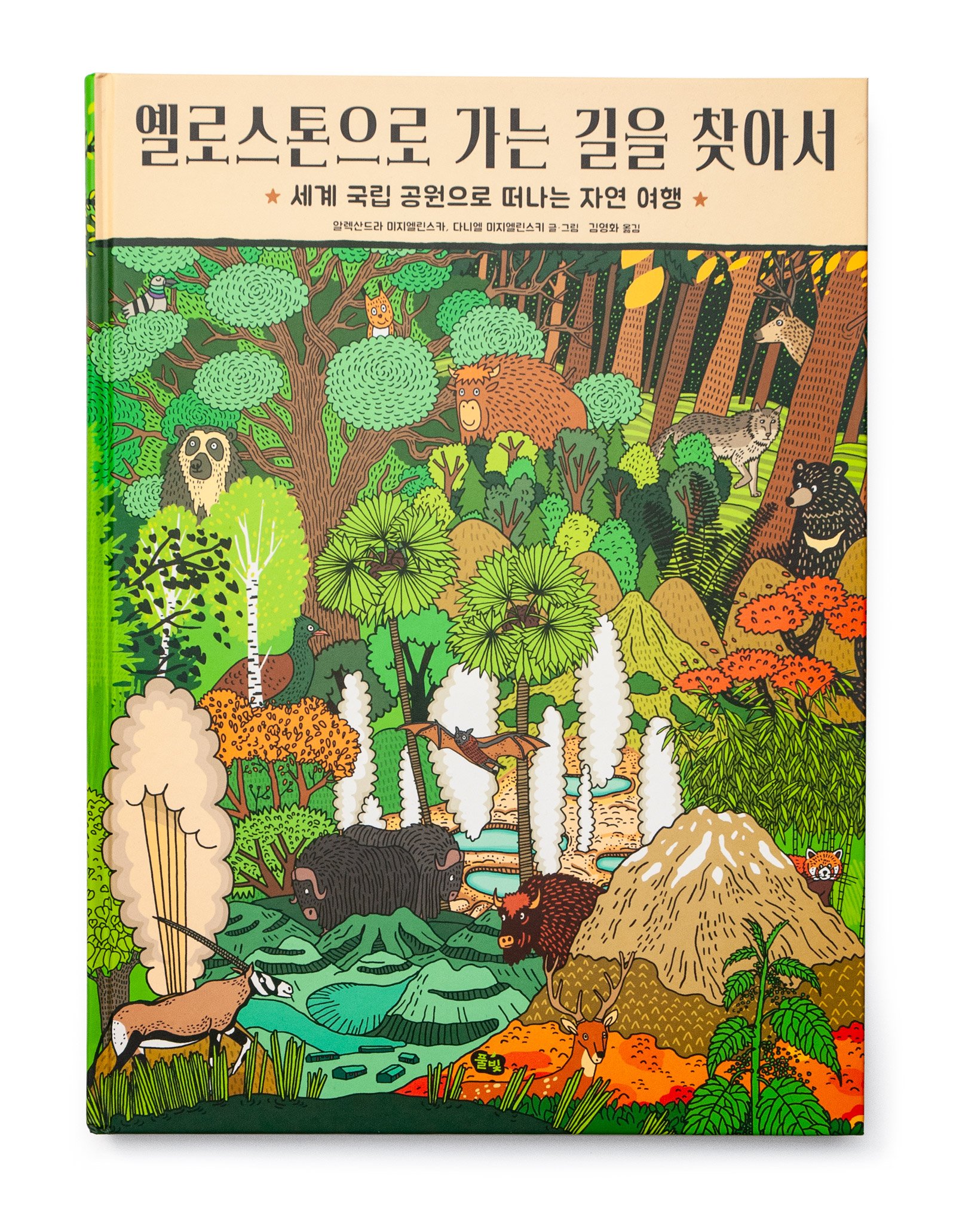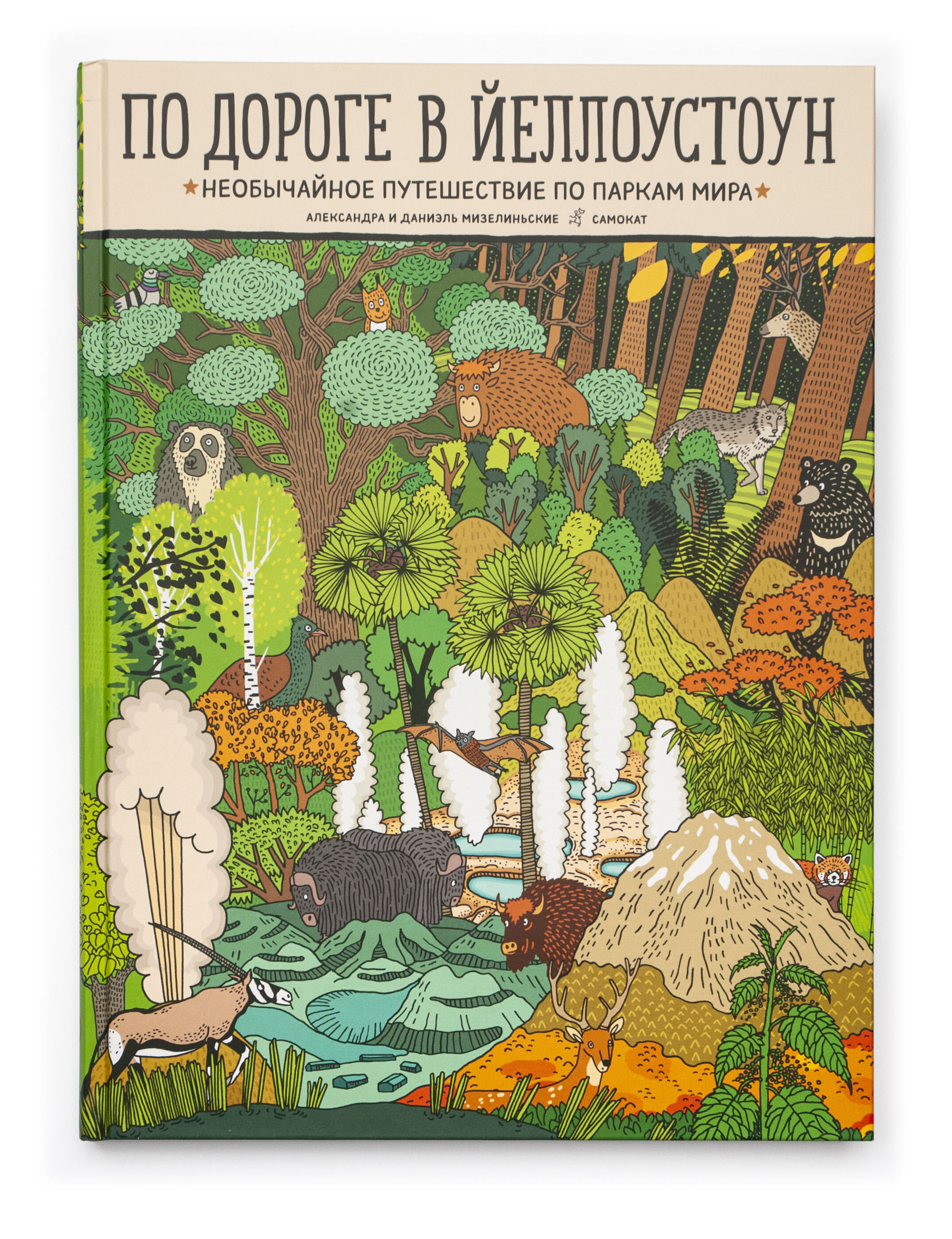Którędy do Yellowstone?
English title: Which Way to Yellowstone?
Publisher: Wydawnictwo Dwie Siostry
Warsaw 2020
Dimensions: 27.2 × 37 cm
Hardcover: 128 p.
ISBN: 978-83-8150-062-3
Book received a Special Mention at the 2021 BolognaRagazzi Award in the Comics Middle Grade category.
A couple of engaging friends – the European bison Kuba and the squirrel Ula – set out on a fascinating journey through eight extraordinary national parks: starting from Białowieża National Park in Poland, they embark on a journey to Yellowstone (USA), to move later to Manú Park in Peru, and head for Jiuzhaigou (China), pass by the desert Namib-Naukluft Park in Namibia to visit Greenland; then they visit Komodo (Indonesia), to finish up in Fiordland in New Zealand.
This book is another entry in our 10 years in the making not so very consistent series of educational oversized picture books. Non fiction children’s books were on our minds for the last 15 years but the big books started with Maps and Under Water/Under Earth that followed a few years after.
This time we focused on nature. Animals, plants and habitats they live in. We wanted to show how specific environments shape the life that flourishes in them. And because human intervention is inevitable, we wanted to present our conserving and transforming capabilities. For the former we chose national parks because preserving nature was the concept they were created upon. For the latter we had a lot of stories to choose from: from the overhunting of american bison to introducing invasive species and practically replacing the flora and fauna of New Zealand.
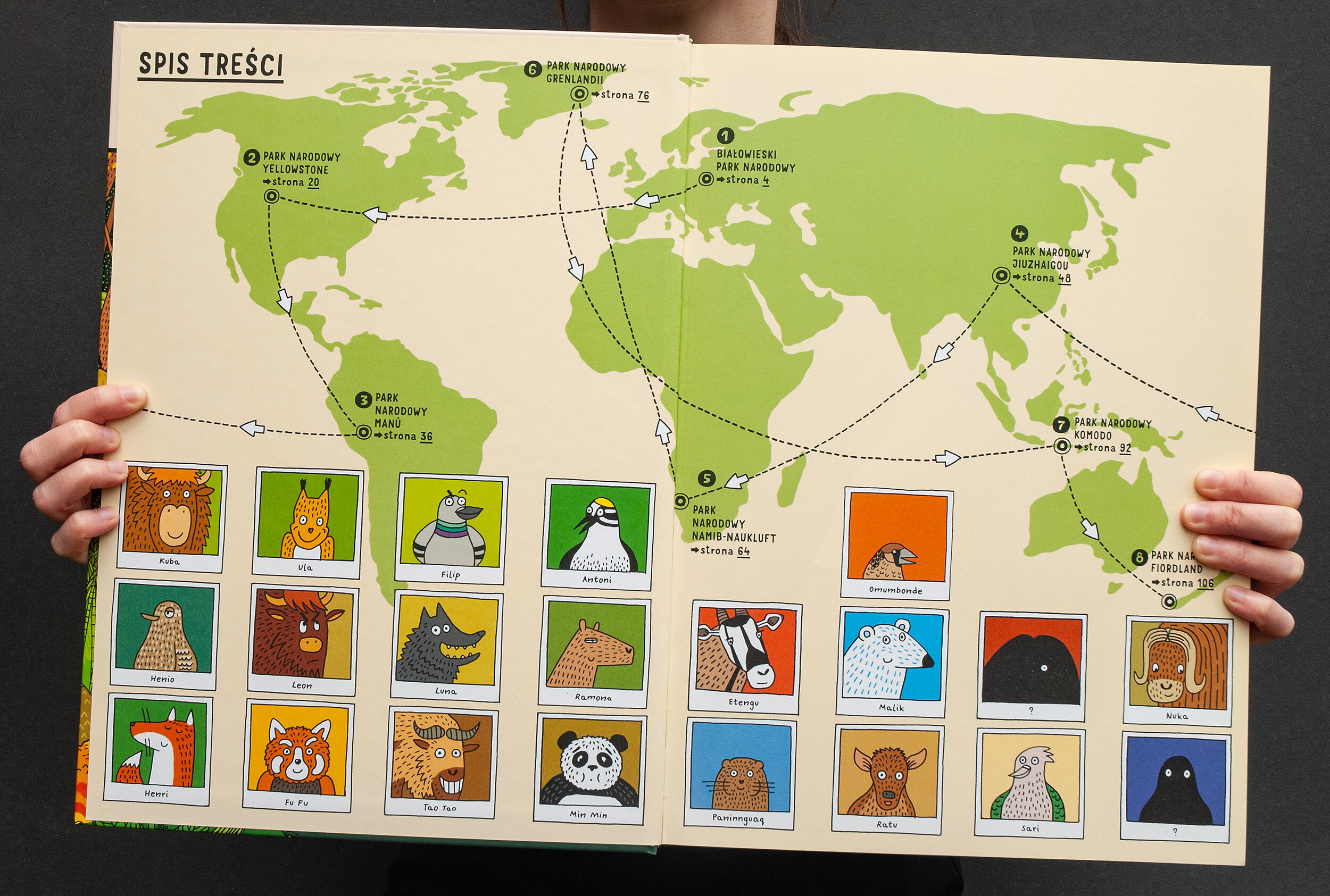
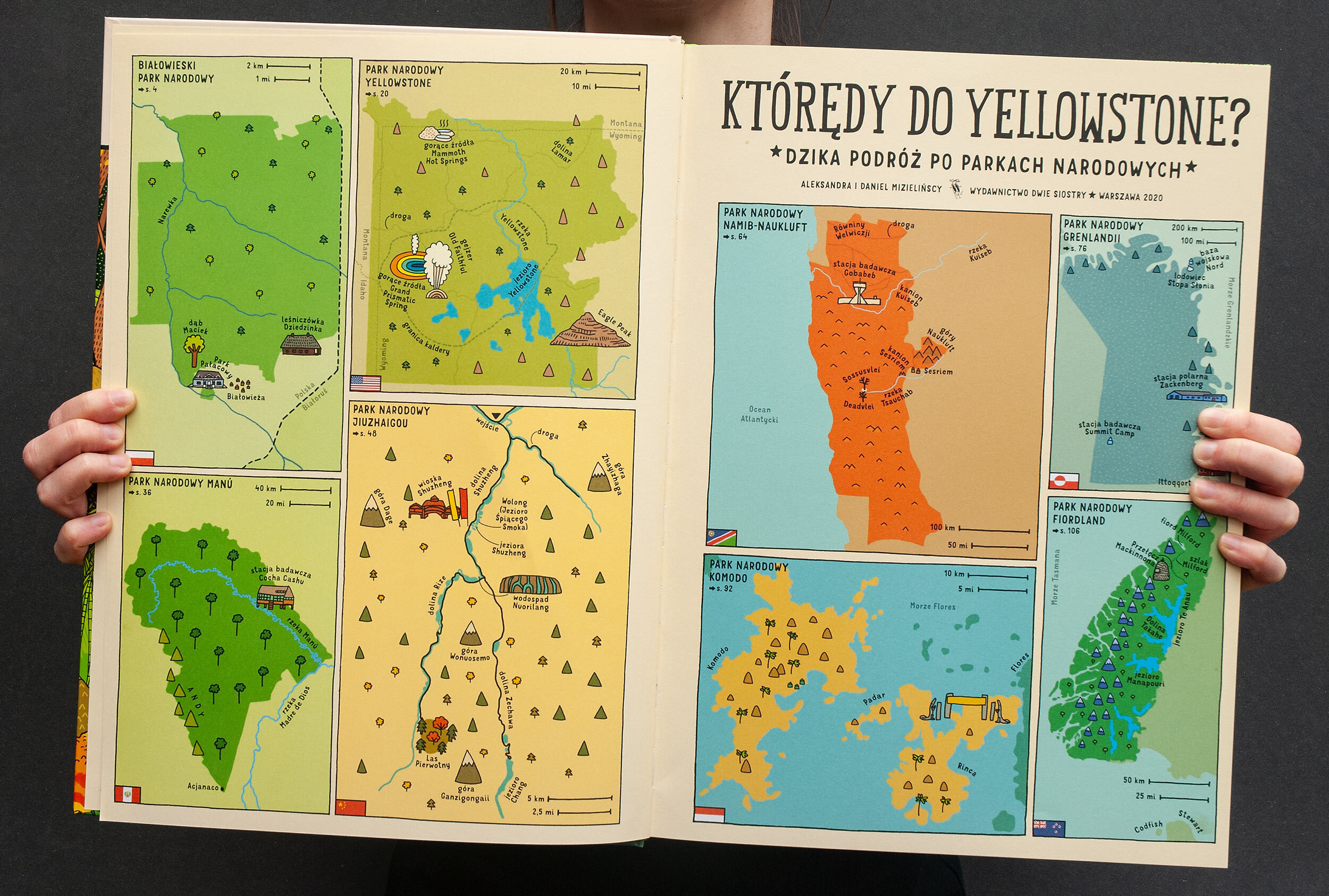
Selecting Parks
The first decision, after establishing that national parks would be the stage for both the fictional and educational story, was choosing right parks. We live in Poland, so we wanted the story to start here. We could, for example, go with Tatra National Park, but we ended up with Białowieża National Park because of its Europe’s last primaeval forest and one of the most impressive animals living in Poland – the European bison.
From there it was easy to make a connection with Yellowstone National Park – the first and certainly most famous national park of the world. The other associations were the common ancestors of American and European bison, almost successful eradication of both species, and a lucky reintroduction. Also, the topic of wolves came as a fortuitous bonus (this time).
New Zealand is an amazing example of humans carelessly replacing almost all living creatures by introducing foreign plants and animals (including predators), so Fiordland National Park was the next park in line (even though it ended up to be the last stop in Kuba’s and Ula’s journey).
The Chinese Jiuzhaigou is a beautiful place and a great setup for the story of a bamboo forest life cycle and a disappearance of panda bears.
Namib-Naukluft Park in Namibia and Northeast Greenland National Park are both incredible examples of hot and cold deserts with stories of life finding its way even in the harshest conditions.
The Komodo island in Indonesia was chosen because of the real, living dragons that walk among natives as if they were taken straight from a fairytale.
Finally, Manú National Park was chosen for its biodiversity and Amazon rainforest.
Although…
The Manú and Namib-Naukluft parks were not included the first time we finished the book. Yes. We did send the finished book to our editor on March 2019 and then resent it on September with additional 24 pages and rewritten main plot. Why?
After presenting the book to potential foreign publishers some of them asked why Africa is not represented in the book (they didn’t mind that South America or Antarctica were also absent). At first this question seemed ridiculous to us, because when selecting parks we didn’t think about continents, and obviously none of those places are representative for the whole continent.
We struggled with this problem for a day or two, because we like our books to be planned carefully in advance and this would cause big changes to the core of the story. Also, we couldn’t add a park from Africa without adding one from South America.
On the other hand, we already had ideas for the richness of the Amazon rainforest and harshness of Namibian, desert so we decided to go for it.
There were still a few months till Christmas so we had time. It took us over 3 months of intense work, but in the end, the book came out better. Not because we can tick the African checkbox, but because we’re happy with the added stories.


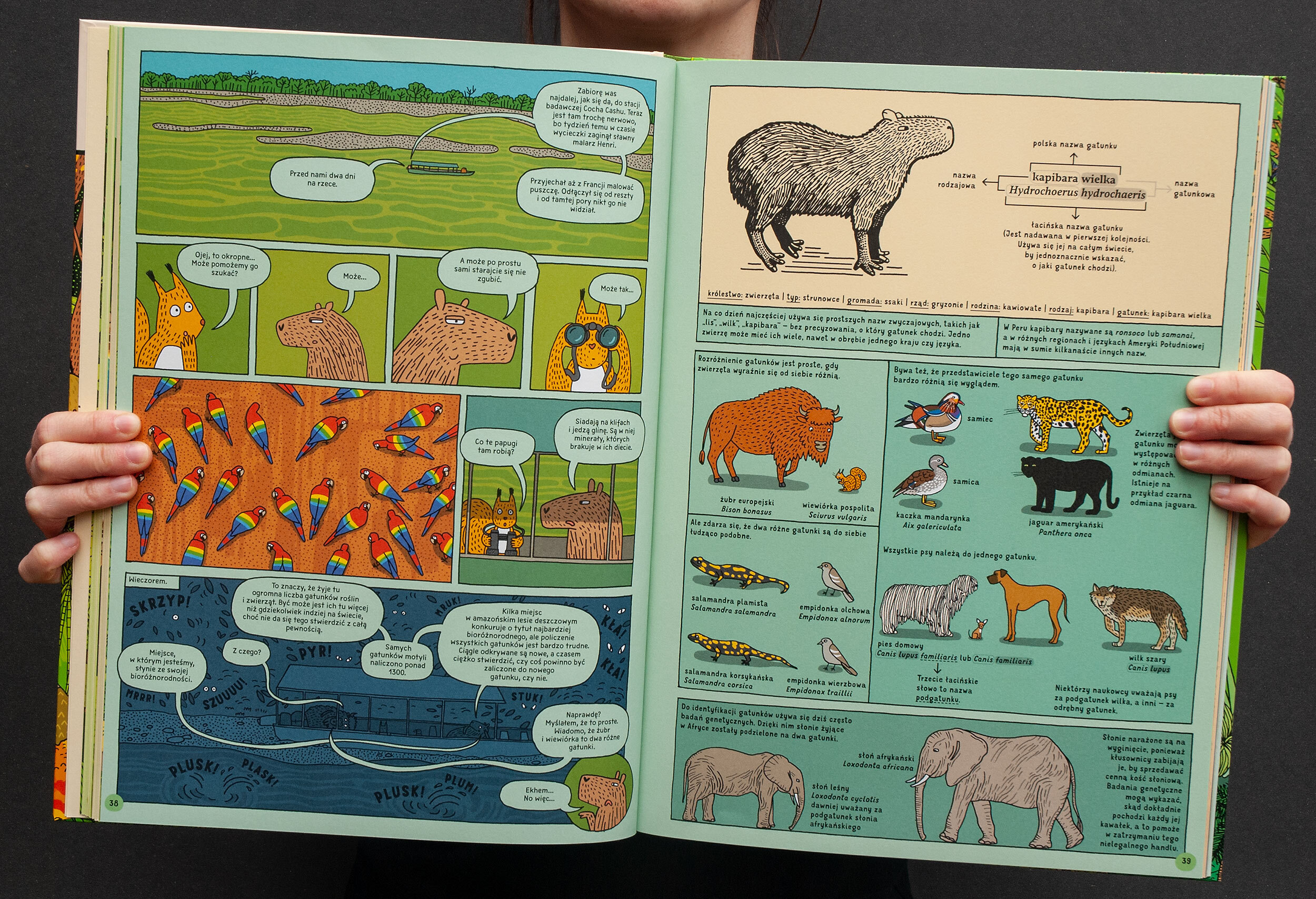
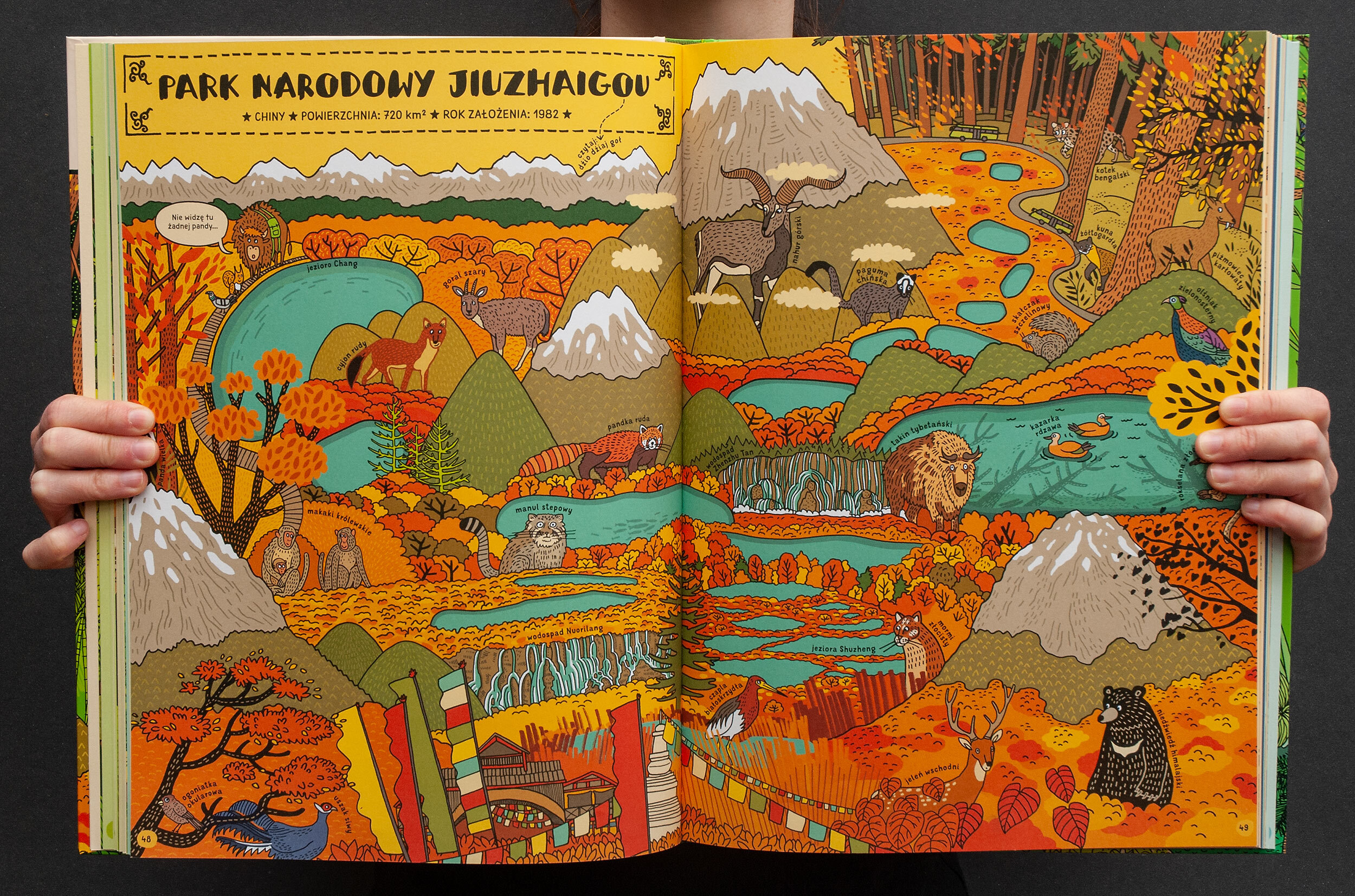
Why comics?
Since “D.O.M.E.K.”, our main tool in creating books was not illustration or graphic design, but sense of humor, and we found comics to be a great vehicle for it. “Which Way to Yellowstone?” is our first proper comic book, but we have been telling stories using juxtaposed images for about 13 years now. We notoriously used speech bubbles, masking and other vocabulary typical for comic books.
Why go all the way with this project? For us, every book is an opportunity to try new things. This time we wanted to have a fictional story that would help us convey educational content. Comic was a natural choice considering that our work was always gravitating to this genre. We’ve been collecting comics since the 90s, and that Daniel teaches comic book design at Academy of Fine Arts in Warsaw, Poland. Looking ahead we know that this won’t be our last entry in this medium.
Characters
At this point we knew what we wanted to write about, and we needed some lovable characters. European bison (“Żubr” in polish) was an obvious choice. He’s huge (the largest herbivore in Europe), rare (was driven to extinction), has a backstory that matches all of the main concepts featured in the book, and has a strong Polish connotations. This is how Kuba came to life. He is shy, he’s afraid of flying, and doesn’t really want to travel.
Fortunately, his best friend is his complete opposite. Ula is a small and joyful squirrel. She’s in love with the world. She likes learning new things and meeting new creatures. She’s a problem solver and a character that can provide answers when necessary.
Finally, Filip was added to spice things up, as it’s good to have one grumbler among otherwise positive characters.
After agreeing on personality, goals, and backgrounds of the main characters, we could finally draw them. This process is always a lot of fun. We can make a lot of quick sketches showing different expressions and situations.
Early mistake
Regrettably, at this stage we made a mistake that would cost us a lot of work 2 years later. The design of Kuba that we’ve been using until finishing the first draft of the book had a kind of mane. This could be just an individual trait, but unfortunately, the mane is one of the features that distinguish European and American bison. We even drew a figure illustrating this, but we hadn’t noticed any problem until Maciej Byliniak (chief editor at Wydawnictwo Dwie Siostry) pointed it to us. In result, we had to redraw parts of every panel where Kuba appears.
Ula’s herbarium
A lot of topics we covered orbit around animals and there are only few focused on plants. Ula’s herbarium was added to counterweight resulting imbalance and encourage readers to draw their own herbaria.
All of the plants are hand drawn on paper (yes, analogue, regular paper). The difference in technique between the herbarium and the rest of the book lies in the way we applied colors. We wanted the herbarium to have more organic and sketchy look, so instead of applying colors in Photoshop we used markers to make the fillings. Unfortunately, this traditional approach has a significant inconvenience: adjusting colors is a drag.
To keep the freedom and ease of manipulating colors digitally, we used an old printing trick. All of the color fillings were drawn using single color on a separate sheet of thin, semi-transparent paper. This way we could create analog equivalent of Photoshop layers. The stroke was scanned and cleaned, and the fill with all of the resulting texture was used as a mask for the solid color layer in Photoshop. This way we could change the color with just one click and a drag, still preserving the uniqueness of an analog tool.
Ula’s herbarium was a source of another big problem we had to fix during final edits. To make the herbarium credible, the plants presented there had to match not only the location Ula was drawing them at, but also the development stage the plants would be at in that particular time. There are exceptions to this rule (when Ula is saying that she copied flowers from a book), but, in general, we tried to be in sync with an established timeline.
We decided on key moments (for example, characters had to be in Jiuzhaigou during fall) and tried to tag scenes in between with appropriate labels, so everything would fit nicely together.
When Maciej Byliniak tried to reverse engineer all of the dates, he ended up with precise dates that were totally different than our loose estimates.
To fix the timing we changed some of the labels, making some of the adventures longer and others shorter. We didn’t avoid replacing some of the plants, but in the end, the herbarium represents a credible collection of plants that could be seen by our characters during their journey.
Making of
As with every new project, first few spreads will always have different vibe than the rest of the book. This is because every time we try to reevaluate our workshop and find the most efficient and satisfying workflows for particular tasks (to minimize stylistic inconsistencies resulting from this process, we try to avoid creating those first spreads in order).
At first we thought that having a notebook with rough layout of panels with marked essential elements on them would be a quickest way to plan every chapter (park) in the book. But with a book this size it’s hard to remember about scale. Then we tried to sketch things on a one-to-one size paper, but it was also counterproductive. Finally, we decided to divide the book into chapters/parks and work on one until it was finished, before moving forward to the next one. Our workflow looked something like that:
Researching and choosing specific issues that would be the main subject of particular chapter.
Laying out all of the panels directly in Adobe InDesign.
Writing all texts.
Printing layout with texts and filling empty panels with sketches.
Inking final images on thin layout paper.
Scanning images and arranging them to match the layout.
Adding flat color fills in Adobe Photoshop.
There were two types of spreads that had different workflows: the opening spreads and Ula’s herbarium (you can read about it a few paragraphs above).
For the opening spreads we would start with a thorough research of most interesting and representative landmarks, plants, and animals. Then all of the background and foreground elements would be drawn separately (usually as a set of elements on a set of A4 paper) and after scanning, arranged in Photoshop. Applying colors worked exactly the same as with the rest of comic pages – solid color layers in Adobe Photoshop.
Finally, after two years of work, we had to go through a few months of edits, redrawing and revisions and the book was finished.
Problems with the title
Usually our best titles are the same as our working titles. “Maps” or “House” are short, easy to remember and translate. Our working title for this book was simply “Parks” but this couldn’t be an official title. Why? There are two main reasons. We wouldn’t want to mislead potential buyers and the title would probably have to be “National Parks” which sounds like a title of a official guide published by government or some NGO.
Putting stylistics aside, the main argument against “National Parks” was that the book is not about national parks. You won’t find any information about the parks themselves. As I wrote before, this book is about relationship between plants and animals adjusting to surrounding environment and humans influencing this dependency.
We haven’t come up with a good title for a long time. Everyone who knew about the project was trying to help us, but nothing really matched. Finally, someone from Dwie Siostry started trying out more cinematic suggestions, and after a few iterations we decided on the final title. I just hope we won’t have to explain to every foreign publisher why this title is infinite better than “National Parks”.
Animation
Making animations based on our books is a recurring theme. Usually a company tries to convince us that an animated TV show would be a great idea. After that, they show us something nobody would ever want to watch. This time we decided to stay ahead of the problem and commissioned a short pilot episode ourselves. This way, if someone would want to produce a full series, we would have something to show them.
We asked Justyna Maślanka and Justyna Mieleszko to write, direct, and animate a very short story about fires in Yellowstone. We didn’t want to mirror information from the book, but wanted this series to complement a story we’ve already had. Each episode would feature one issue that was not included in the book, but was connected with places visited by Kuba and Ula.
As of today we have no idea if this experiment ever pays off. If something changes, I’ll post an update.
Covid-19
Depending on when you’re reading this and what the final outcome of the infamous coronavirus outbreak is going to be, you’re going to remember or not the time when the whole world couldn’t go outside. I’m writing this post on March 28 and as of today Polish government keeps shutting everything down (even forests!).
These are not the most favourable conditions for concluding three years of work. Our usual print supervision was a bizarre experience. We couldn’t even enter production hall and had to accept prints in the hallway, in the safe distance from the printing house employers. The first run was much lower than usual. We won’t have any workshops for kids, book signings, or anything like that. I’ll set a reminder to update this post a year from now.
Update (October 20, 2023)
My reminder came up after one year and we were still in the middle of pandemic. I snoozed it for a year. One year later nothing changed. So after 3 years it’s time to remove the reminder and write some thoughts. Unfortunately I don’t know if we have any.
During this period we’ve published two different big books (Daj gryza and Wilki) and a small one (Wielka podróż dziadka Eustachego). Którędy do Yellowstone sold pretty well both in Poland and abroad. In Poland it’s on the list of mandatory reading for school kids in grades 1–3 which helped overcoming the stigma of “comic books is not reading” – a harmful conviction shared by a lot of polish parents.
Post Covid Workshops
In the late spring of 2022 polish government lifted almost all Covid restrictions. Our publisher decided that it’s time to go back to workshops, book signing and meeting young readers. We had a ready script for a fun workshop. We were supposed to organize it just after the book launch. We even kept the huge cardboard boxes in our garage for the 3 years of pandemic.
The premise was simple. Let’s build a huge, colorful European Bison. I think the outcome was quite impressive and all the kids did tremendous job putting it all together.
Foreign editions
Korean, 옐로스톤으로 가는 길은 어디일까?, Pulbit Publishing Co., 2021, ISBN: 978-11-6172-430-0
Italian, Da che parte per Yellowstone?, L'Ippocampo, Milano, 2021, ISBN: 978-88-6722-636-8
Japanese, 国 立 公 園 へ 行 こ う !, Tokuma Shoten Publishing Co., 2021, ISBN: 978-4-19-865330-9
Chinese, 世界国家公园, Beijing Dandelion Children's Book House, 2021, ISBN: 978-7-221-16396-7
Taiwanese, 出發吧!環遊世界國家公園, Global Kids Books, 2021, ISBN: 978-986-525-033-1
Spanish, ¿Cómo se va a Yellowstone?, Maeva Young, 2021, ISBN: 978-84-18184-38-3
Russian, По дороге в Йеллоустоун, Самокат, 2021, ISBN: 978-5-00167-067-4
Slovak, Cesta do divočiny, Slovart, 2021, ISBN: 978-80-556-5041-8
Dutch, Ga Je Mee Naar Yellowstone?, Lannoo, 2020, ISBN: 978-94-014-6638-7
Czech, Cesta do divočiny, Host, 2020, ISBN: 978-80-275-0252-3
German, Auf nach Yellowstone!, Moritz Verlag, 2020, ISBN: 978-3-89565-400-8
French, C'est par où Yellowstone ?, Édition Milan, 2020, ISBN: 978-2-4080-2027-9
You can find a Google Sheet with a list of all our foreign editions here.


